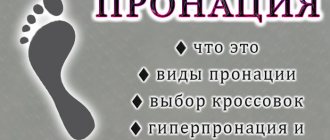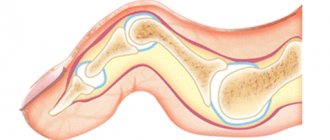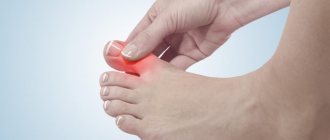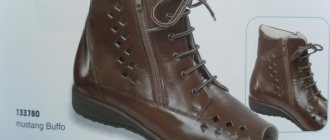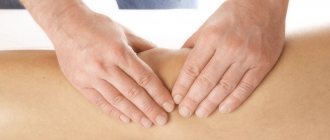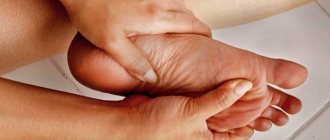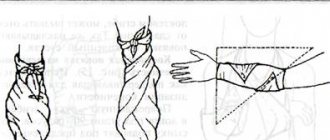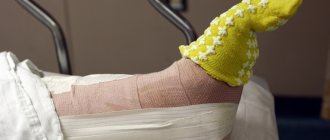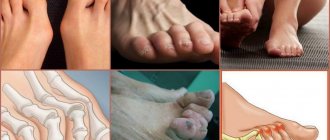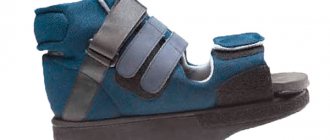Buying beautiful shoes becomes a problem, and a long walk turns into torture? Corns, bunions, calluses, deformed joints and corns are a pain that every second woman faces. The result is surgery and a long recovery process. But, besides surgical intervention, there is a solution to this problem and more than one! The main thing is to choose it correctly. This is exactly what we will talk about in the article. How to choose correctors and liners
, what to pay attention to and whether it is actually possible to get rid of the “bone” forever without surgery.
Design
The clamp consists of two parts:
- a soft gel petal that adheres to the bone of the big toe and protects the sore spot from rubbing with shoes and other influences. This detail reduces pain when walking and allows you to wear different shoes;
- gel roller that moves the big toe away from the foot. The effect is gentle, without pain or other unpleasant sensations. The foot takes on a healthy appearance.
Thanks to its design, the device fits tightly around the finger and does not protrude. And the soft, velvety plastic does not cause irritation or chafe the skin. The polymer from which the device is made is easy to clean, dries quickly and does not deform when worn.
History of the creation of the proofreader
The hallux valgus corrector was invented and patented by German traumatologists while studying the problems of deformation of the joints of the foot. Thanks to the use of elastic materials, the orthopedic device fits tightly to the skin. This makes walking easier and makes it possible to use the brace for several hours every day.
American orthopedists also worked on the problem: obesity, which affects the majority of the population, is accompanied by the development of Hallux valgus. The Americans have improved the design of the latch and created several convenient varieties that are used throughout the world. Correctors appeared in Russia about ten years ago. Work continues to improve existing modifications.
How does deformity form on the foot?
To understand the work of the clamp, you need to understand the mechanism of deformation formation. The human foot is initially designed to bear an even load, but when wearing high-heeled shoes, the center of gravity shifts forward, and narrow shoes deform the foot, improperly distributing body weight.
This leads to overload of some muscles and disruption of others. As a result, the muscle fibers that hold the big toe in place relax, and it begins to deviate towards the foot. In the area of the metatarsophalangeal joint, a tubercle is formed - a bone, which gradually begins to grow.
Incorrect position of the thumb and changes in its physiological angle cause premature wear of the articular cartilage and bone apparatus. Chronic joint inflammation occurs - bursitis, and patches of rough skin - corns - appear on the back of the leg.
Choosing the necessary orthopedic device
It is advisable to independently choose only thumb clamps for comfortable wearing of shoes, for example, a cover made of natural materials. And the model necessary for the treatment or prevention of diseases is determined only by a doctor - an orthopedist, rheumatologist, or traumatologist. He makes all the necessary measurements and sets the degree of rigidity required to correct the position of the thumb.
If the fixator is intended for treatment, then you just need to go to an orthopedic salon with a doctor’s prescription. The consultant will offer several models that will differ in cost. The range of preventive devices is more diverse. When choosing, you need to take into account the ease of wearing and care, the quality of the materials used in the manufacture.
Properties of the insert and its mechanism of action
To correct the deformity, the finger is returned to its physiological position and secured with a clamp. The weight of the leg is distributed correctly, and the joint begins to recover. Walking becomes easier, pain and swelling of the legs disappear. The bones become less noticeable.
The device does not interfere with wearing sandals and shoes, does not damage the skin, does not cause calluses, diaper rash, or allergies.
Constant use of the device returns the finger to its normal state, teaching the foot to the correct distribution of support. With mild degrees of the disease, you can remove the protruding bone and return the finger to its place without surgery. In more severe cases, it will not be possible to completely eliminate the curvature, but the leg will hurt much less and the deformity will stop progressing.
In addition, the Valgus Pro retainer:
- relieves the sore joint when walking, keeping it in the correct position throughout the day;
- eliminates pain and burning when walking caused by rubbing of deformed fingers against each other;
- prevents the formation of calluses, corns and swelling on the feet.
Finger bandages: varieties
Several different types of orthopedic devices have been created to treat and prevent thumb deformities. They differ significantly in parameters, which depend on the purpose of the orthoses. Depending on the stage of damage to the joint and the limitation of its functions, existing spacers for the finger vary:
- method of application;
- the material from which they are made;
- design.
Taking into account the time of wearing a therapeutic bandage, there are:
- Night splints are hard splints for sleeping.
- Daytime ones are soft and articulated devices that can be comfortably worn with shoes. They do not relieve inflammation, but make walking easier, therefore they are indicated for patients with the initial stage of pathology and are necessary for people in standing professions.
Correctors are made from different materials. Exist:
- silicone (gel);
- plastic (Ortmann Dans);
- fabric (made in the form of socks with special inserts and separators for fingers inside);
- combined (have a plastic frame with soft silicone inserts, which allows you to adjust them to size and wear them all day).
If it is possible to change the angle of finger abduction, the clamps are divided into the following types:
- Adjustable, for night wear - a splint made of hard plastic reliably holds the toe and foot in the correct position, making them inactive.
- Unregulated – designed for any time of day; made of elastic material, do not interfere with walking.
Orthopedic devices are divided according to the presence of additional interdigital spacers. The result of treatment depends on the stage of the pathology.
Silicone retainer
Silicone toe clips are the most convenient to use, since they can be comfortably worn in any shoe. They are durable, do not rub, do not cause calluses, and are small in size. They often take the form of a solid cast tab, located between the fingers, well holding the joints in their anatomical position. Produced in two versions:
- Intertoe roller - reduces and evenly distributes the load on the foot, prevents crossing of the toes while walking, and secures the joints well.
- If you add a silicone pad (tongue) to the roller for the bump, it will be called a bursoprotector. Protects the formed bone from damage by covering it. It is held in place by a ring that is attached to the finger. Protectors are made with a grooved surface: this additionally normalizes the blood supply that is disrupted in the damaged area.
Several types of soft silicone correctors are used in orthopedics:
- Valgus Pro;
- Valgus Plus;
- Ortus.
They all have the same design - it is an elastic and elastic interdigital spacer (septum). The protector should be worn on the first curved toe. Valgus Pro and Ortus are small in size, manufactured by different companies (Medicus and Ruges, respectively), and therefore differ in price. Valgus Plus (Medicus) covers almost the entire foot, its cost is higher.
The devices do not have fasteners and delicately fix the fingers in a given physiological position. Designed to correct joint deformities, including children's. They:
- not visible when worn in shoes;
- designed for use up to 10 hours a day;
- prevent the occurrence of calluses and corns;
- reduce pain;
- inexpensive.
Orthoses of this design are easy to use; they are always sold in pairs (for two feet). The roller is more suitable for prevention than for treatment. If the problem is solved, the old corrector can be used in the future by other family members - it does not lose its properties. This is due to the strength of the material, which can withstand heavy loads, does not wear out, and can be used for a long time.
Silicone pads are also placed in shoes along with the insole or replacing it. Recently, molded silicone structures have been developed. They act gently and gradually, effectively bringing the thumb into an anatomically correct position. The devices stop the progression of the disease. In advanced stages, pain is reduced.
Tissue fixative
The bandage, made of fabric, has the shape of a sock with special internal inserts. It affects almost the entire front of the foot. The retainer is designed for daytime wear in closed shoes, as it looks unaesthetic. Recommended for correction of the initial stages of deformation or for its prevention. It is effective in combination with other orthoses because it weakly mobilizes the finger.
Plastic retainer
A plastic corrector is a solid orthopedic device for fixing the thumb. It is a complete treatment device and consists of the following parts:
- splints for fixing all displaced fingers;
- belt to change the degree of tension.
Hinged plastic retainer
is most effective at all stages of deformation, as it provides the highest level of immobilization. Allows you to reliably hold displaced toes in the desired anatomically correct position, increases muscle tone and maintains the satisfactory condition of the foot ligaments.
Contraindications
- Deformation of the big toe, combined with the curvature of other toes. In this situation, you will have to see a doctor and have surgery.
- The presence of postoperative sutures, ulcers, injuries, unhealed wounds and injuries in the area where the fixator is worn.
- The tendency of the skin to form trophic ulcers in diabetic feet.
- Rheumatic lesions of the joints of the foot. In this case, the use of liners is ineffective. To eliminate the problem, antirheumatic treatment is required.
- Fungal and microbial infections of the skin of the foot.
Tips for use
Daytime correctors, silicone pads, and finger spacers are quite easy to use. But the first installation of a night orthosis or valgus splint takes place in the doctor’s office. He shows how to correctly position the clamp and set the required thumb abduction angle.
The duration of daily wearing of orthopedic devices is from 2 to 12 hours. With prolonged use, you need to take short breaks after 1-2 hours, since due to tissue compression, blood circulation in the forefoot worsens.
Night orthoses are put on in the evening and removed only in the morning. Some patients experience discomfort from this method of treatment - their sleep is upset, in the morning they feel lethargic and overwhelmed. In such cases, taking mild sedatives helps.
Features of application
To achieve a visible effect, the insert must be worn for 6-10 hours a day. It is quite easy to put on and take off – just stick your finger into the device.
In the first days, minor inconvenience may be observed, since the leg has become unaccustomed to being in its normal position. This goes away later. Patients wearing such a device often make the mistake of immediately starting to put on their usual tight shoes. This should not be done, since the use of a fixative will be ineffective.
The use of Valgus Pro enhances the effect of creams, ointments, physiotherapeutic treatment, massage and physical therapy.
Where to buy a quality product
Corsets for bunions are sold everywhere. On the Internet, hundreds of non-existent stores sell fixatives of dubious quality. Most of these products come from China; the products do not pass safety tests and are made from materials that can be toxic.
High-quality bunion fixators can cost about 1.5 – 3 thousand rubles. You can buy a certified product at a pharmacy or make an individual corrector to order at an orthopedic clinic.
Alternatives
- Osteotomy surgery is a radical solution to the problem, unfortunately associated with the risk of complications and a long recovery period. It can be used for severe changes in the joint that cannot be corrected using non-surgical methods.
- Orthopedic insoles, which correct the position of the toes and reduce pain, are wide and uncomfortable, so they cannot be worn with most shoe models.
- Orthopedic splints that rigidly fix the finger and joint cost up to 4,000 rubles, which is almost 10 times more expensive than Valgus Pro.
Valgus Pro fasteners are convenient and inexpensive devices that do not rub the skin, do not cause side effects and are compatible with most shoe models. This is an ideal option for correcting hallux valgus.
Types of operations
There are 3 types of operations for Hallux Valgus:
- On soft tissues. Effective for grade 1 deformation. The goal is to restore the uniformity of traction of the abductor and adductor muscles.
- On the bones. Indicated for deformity of 2, 3 degrees for the purpose of resection of a painful formation.
- Combined. Carry out in cases of severe impairment of the supporting function of the foot. They consist of a combination of removal of bone growth and plastic surgery of sprained ligaments.
There are more than 300 surgical options to remove the painful growth. In the initial stages of the disease, doctors try to use minimally invasive techniques so that the patient recovers faster. But if the disease is advanced, more complex surgical interventions are required.
Operation McBride
A popular operation on the soft tissues of the foot. Its essence is to move the adductor tendon to the head of the 1st metatarsal bone. Due to this, it is possible to bring the metatarsal bones closer together and restore normal muscle-tendon balance. After surgery, it must be taken into account that the abductor pollicis muscle cannot withstand a constant load for a long time.
If after treatment the patient does not follow the doctor’s recommendations and does not eliminate risk factors for the disease, there is a possibility that the deformity will reoccur. After correction, you must wear orthopedic shoes, avoid heavy physical activity, and avoid wearing heels and tight shoes. Unfortunately, the latter becomes a problem for many women, which is why in 95% of cases they suffer from hallux valgus.
SERI
A minimally invasive technique in which an osteotomy of the first metatarsal bone is performed through a small incision of 1-2 cm. The head of the bone is moved in the desired direction, and the bone fragments are fixed with special knitting needles, which are removed after a month. The operation is used for mild to moderate deformity.
SCARF
Scarf osteotomy is the gold standard for the treatment of hallux valgus. This is a suitable operation for moderate to severe forms of Hallux Valgus and helps to correct the rotation of the thumb around its axis. An incision on the inside of the foot allows access to the bone.
Using a special microsaw, the surgeon cuts out a Z-shaped section of the first metatarsal bone. Next, its head is shifted at the desired angle to the correct position. The bone fragments are fixed with titanium screws for stability of the connection. After complete fusion, they are removed, but if they do not cause discomfort, they can be left in the body. In particularly complex clinical cases, this operation is supplemented with other techniques.
CHEVRON
Chevron osteotomy (Austin operation) is used to correct mild to moderate deformity. Allows you to adjust the angle between the 1st and 2nd metatarsal bones. The operation is named after the V-shaped military patch called a chevron. Another name, Austin osteotomy, is associated with the name of the doctor who first performed it.
The operation begins with a V-shaped cut of the first metatarsal bone near its head. The bone fragment is moved taking into account the configuration of the bones of the foot. Bone fragments are fixed in the required position using a variety of fixators: Brauk intracortical screw, wires, wire, cortical screw, etc. Excess bone tissue on the medial side is removed.
Operation Ludloff
Technique used for moderate deformity. It is based on a wedge-shaped cut of the first metatarsal bone and moving the distal part of the bone inward. It is shifted in such a way as to solve the main problem - too large an angle between the 1st and 2nd metatarsal bones. The bone fragments are stabilized with screws, and the joint capsule is additionally sutured to reduce valgus deviation.
Operation Schede-Brandes
The technique can be called classical, but it is used less and less. The point is to simply remove the protruding part of the head of the first metatarsal bone through an oblong incision about 5 cm long. The attitude of specialists towards this technique is ambiguous, since there are a number of disadvantages. But there are also positive aspects - the operation is simple, does not require complex tools or metal structures. It can be performed without applying tourniquets, which is important for patients with chronic venous insufficiency.
Arthrodesis
It consists of complete immobilization of the metatarsal-wedge joint by fusion of its bones. The operation is aimed at imparting strength by blocking mobility. The bones are firmly secured with metal clamps - pins, knitting needles, screws. After their installation, the surfaces of the joint grow together at a certain angle and the joint becomes motionless.
The operation is carried out in two ways. The first is classic (open), in which manipulations are carried out through incisions. The second is arthroscopic, all actions take place through small incisions using an arthroscope. Without a doubt, arthrodesis is a more traumatic operation, but it helps people live without pain.
